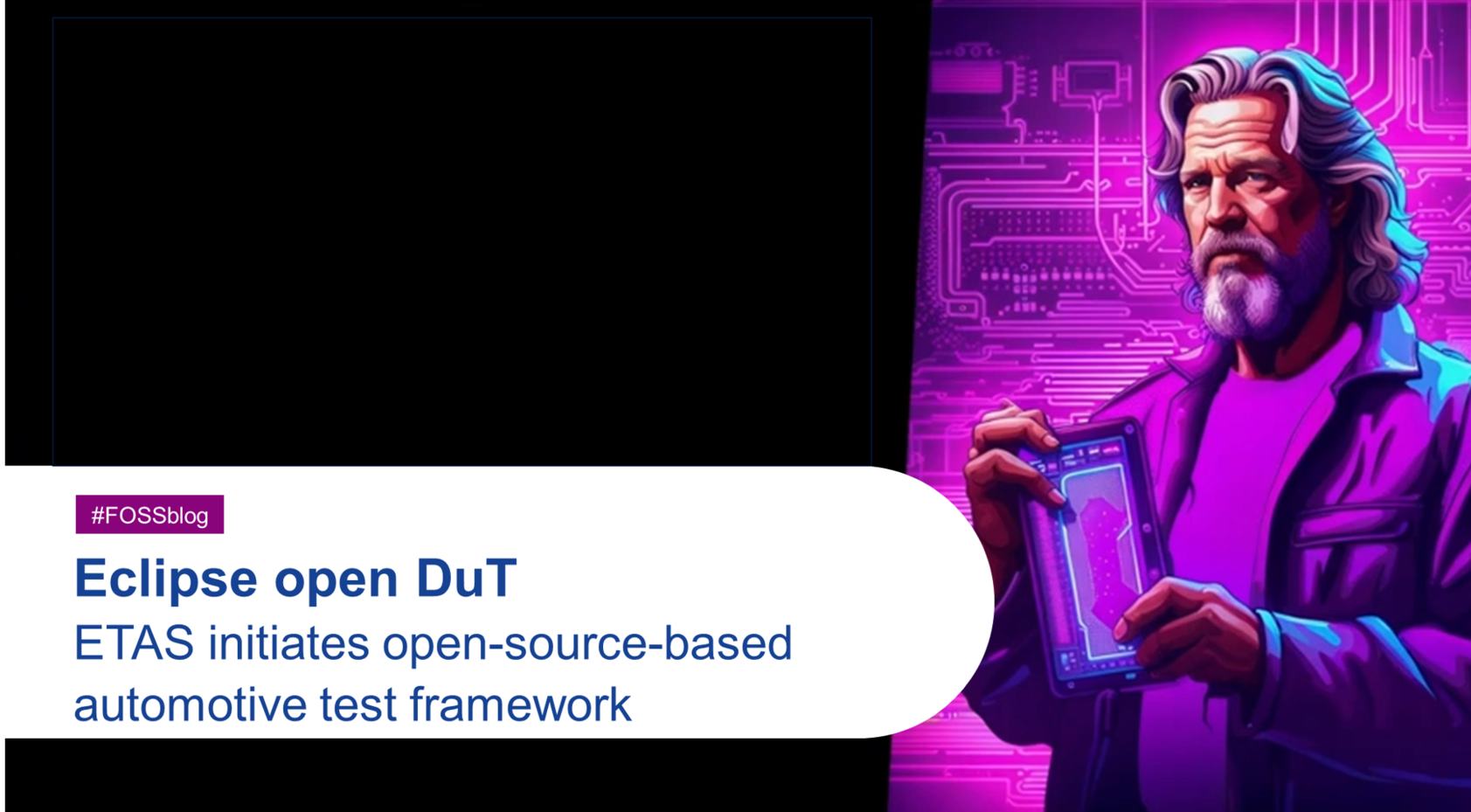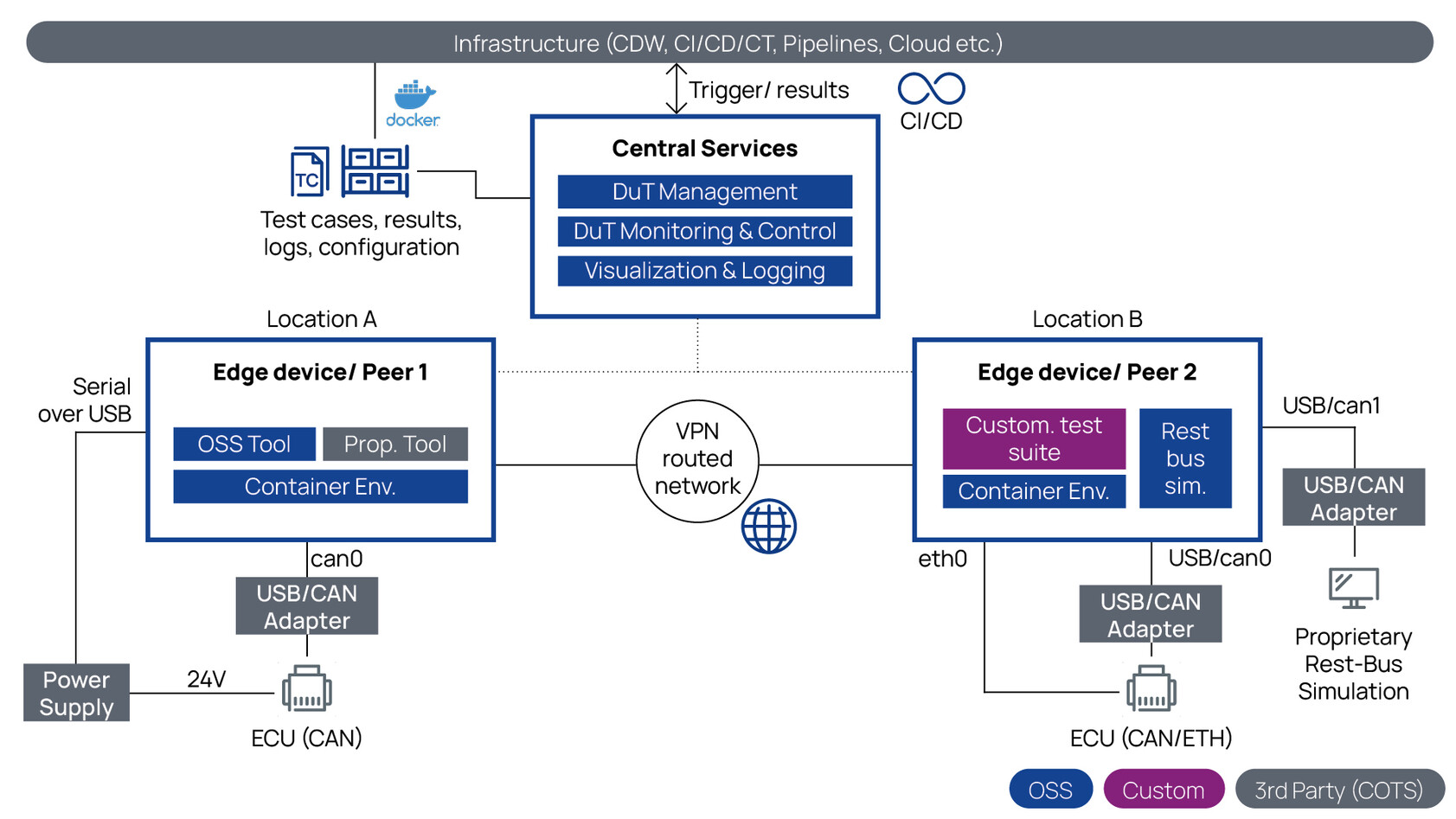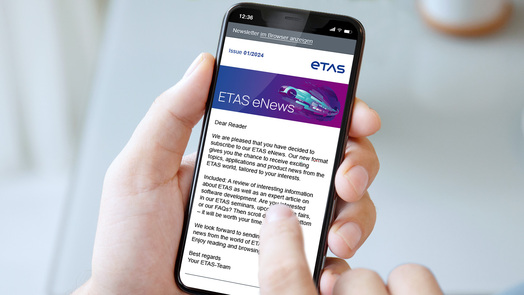09/06/2024
Eclipse open DuT
ETAS initiates open-source-based automotive test framework

ETAS is developing an open-source-based test automation framework for automotive systems together with renowned partners such as VW/CARIAD, Mercedes Benz Tech Innovation, and AVL. The project is being realized under the name “Eclipse openDuT” (Device under Test) and under the umbrella of the Eclipse Software-defined Vehicle Working Group. The aim is to create an open validation & verification solution that enables automated, location independent, flexible automotive testing without great expenditure of time and money.
Today, the tool landscape in the automotive testing sector is quite fragmented and predominantly offers proprietary solutions that are incompatible with one another. Users such as automotive manufacturers and suppliers quickly become dependent on individual providers (vendor lock-in effect). At the same time, many commercial testing tools already consist largely of open-source components – a hybrid situation that causes dissatisfaction among users. Or, as the project manager of a large automotive manufacturer and ETAS customer recently put it, “Due to the already high proportion of open-source code in today’s proprietary testing tools, we as users are no longer willing to pay for the redevelopment of entire test benches in order to subsequently receive an isolated proprietary solution.”
Thomas Irmscher, Product Manager Security Testing Services at ETAS, understands this well. As co-initiator, he would therefore like to remedy the situation with the Eclipse openDuT project: “We see a real need for action here and a great opportunity to create, with the help of the open-source community and with partners and future users, a versatile test automation framework that maps the non-differentiable part of such an application.”
The glue for an automotive (cybersecurity) test automation ecosystem
The Eclipse openDuT framework focuses on automating and integrating the test and validation process for automotive software and components into existing infrastructures. In future, this framework will provide the basic and necessary fundament for testing automotive systems and will, with its modular and open structure, support as many test applications as possible: security testing as well as safety and functional tests for individual automotive components as well as for systems in a network or for homologation purposes (e.g., for type approval in accordance with UN-R155).
The participation of experienced automotive industry experts (OEMs & Tier1) ensures practical relevance and domain knowledge, such as integration of automotive particularities (e.g., DuT management or rest bus simulations) and focus on extensibility for integration into native systems (e.g. OpenTestSpecification [1] or AUTOSAR). Consequently, within the test automation framework, users can continue to resort to proprietary test applications available on the market and define and integrate their individual test methods – for example, as black or grey box tests or across geographically dispersed test benches.

The separation concept of differentiation and non-differentiating software can be explained by Fig. 1. With fulfilling predominantly the test facilitation aspects, Eclipse openDuT represents the non-differentiating part of the V&V framework. The benefit of an open-source based testing infrastructure lies in the opportunity to include test applications of various context within the test execution layer, i.e., integrating market available test tools (commercial of the shelf) with different license types (FOSS, proprietary solutions) as well as test suites that are custom and engineered for a very specific validation purpose (e.g. a secure boot function). In addition, the test facilitation and execution should be accompanied by an integration into the user’s test infrastructure, e.g., digital workbenches or test workflows, and an appreciation of the business context, e.g., by test specifications based on system requirements or qualification of the framework for productive usage or type approval audits. The DuT Layer together with the Test Execution and Service & Integration Layer form the differentiating part of a test automation framework. At this point the specific validation requirements and (cybersecurity) goals of the customer products meet the standardized test infrastructure.
Technical aspects and demonstrator setup of Eclipse openDuT

As shown in Fig. 2, the Eclipse openDuT framework consists of an entire IP-routed network infrastructure that is centrally managed and interconnects several edge devices (peers) by a VPN routed network. The edge devices can connect geographically distributed devices under test (DuT) with each other and thereby allow direct ECU-to-ECU communication through the respective automotive protocols (e.g., CAN or SOME/IP). Furthermore, the peers can measure and control each connected DuT by automotive-specific means, e.g., rest bus simulation based on ARXML files, control of an external power-supply, initiate a flashing procedure or trigger the clamps 15/30 via serial communication. In this way, users have maximum flexibility and freedom to adapt the framework to their individual use cases, to integrate it into automated workflows (CI/CD/CT pipelines), or even digital automotive workbenches. Eclipse openDuT can integrate physical ECUs as single devices or clusters within a local testing environment, per cloud, on premise, or in a hybrid deployment. In future, it is planned to implement an interface for Software-in-the-Loop (SiL) environments to run the tests also on virtual ECUs. A setup, as shown in Fig. 2, enables the chaining of different cybersecurity validation steps with different test applications, e.g., a proprietary cybersecurity protocol fuzz tester together with a customized functional test suite written in Python, to cover a significant proportion of type-approval relevant tests for vehicular components. To sum up the main advantage of Eclipse openDuT, the framework allows to combine individual tests from different origins in a single open framework without limitations to ensure an automated and integrated tool chain.
The project was first presented by stakeholders at the EclipseCon conference in Ludwigsburg, Germany, on October 16, 2023. Following official acceptance by the Eclipse Foundation, the implementation of the open-source-based test automation framework is now progressing apace, with ETAS and other partners already providing code (GitHub repository). “In view of the cybersecurity and functional safety requirements of future software-defined vehicles, automotive testing has to become faster, more efficient, and easier to integrate into existing landscapes,” says Irmscher. “With this initiative, we want to create the prerequisites for this.”


